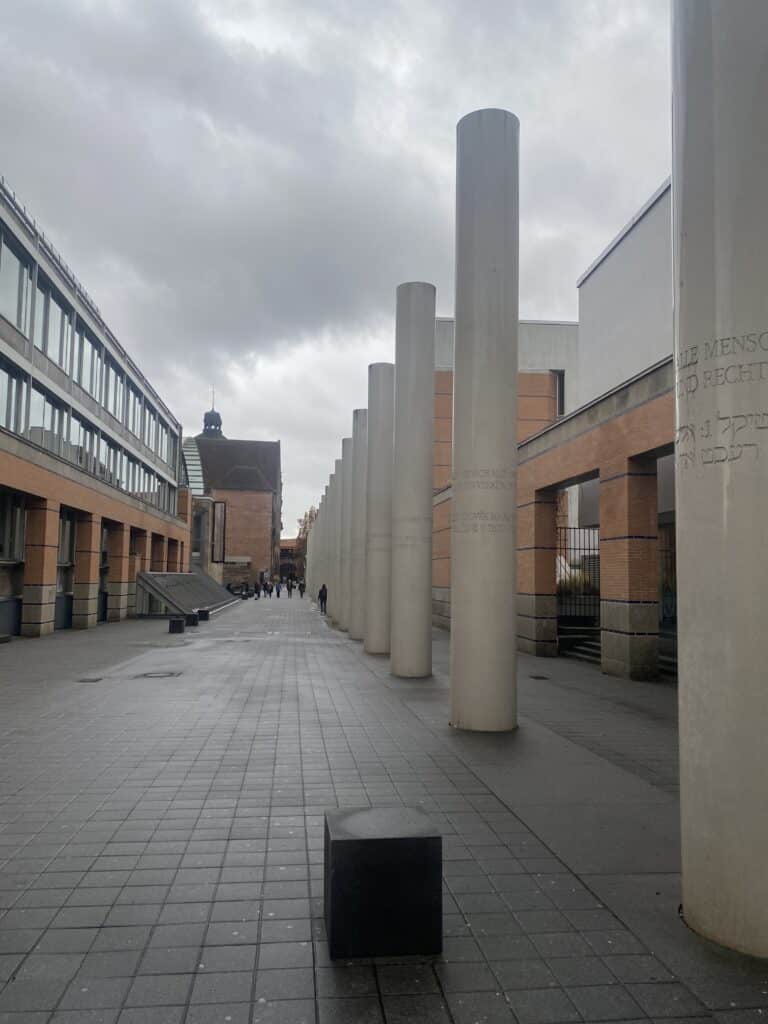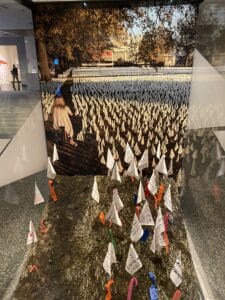When we speak of the European tradition, we should mention Antiquity, Christianity, the Renaissance, the Enlightenment and the European Union. When we visit places related to these, we usually go to Athens, Rome and Paris, but there is one city that should be at the top of the list. It is Nuremberg. I was there a few days ago, and I can say that Nuremberg has seen a lot and is now teaching us not just one lesson, but the entire European heritage.
Nuremberg has seen a lot – from the early Nazi rallies and mobs shouting „Dear Hitler, be so nice and show yourself at the window!”[1] to the erection of the impressive installation of twenty-seven columns in the city center. Each pillar is engraved with an article from the Universal Declaration of Human Rights. But the Declaration itself would not have been possible without the events that took place here from 1945 to 1949.
At the end of 1945, twenty-one men sat together on two benches on one side of courtroom 600 in the Nuremberg Palace of Justice, awaiting judgment. Just a few months earlier, they had been leaders of what they called “a master race” that had committed crimes against many of the people they looked down on. In the opening speech on November 21, 1945, Robert H. Jackson declared: „The Nuremberg Trial will commend itself to posterity as fulfilling humanity’s aspiration to do justice”[2]. The promise of Nuremberg opened a new chapter in the history of mankind. It was not only a promise to punish war crimes or state crimes, but also a promise for a better future – a moral politics and a peaceful coexistence of people of different races, views and belief systems. Most of the former leaders of “a master race” were found guilty and sentenced to death. Their death fulfilled humanity’s aspiration to do justice.
The evaluation of human actions requires the establishment of certain moral norms. And indeed, according to St. Thomas, only that power is good which does not oppress men. It is possible to apply a necessary condition. The way there is through peace (pax) and order (ordo). Let us leave the saints aside and look for the source of the moral politics of politicians. Franklin Delano Roosevelt had already contributed greatly to the enforcement of moral norms in politics. In order to justify not keeping the promise not to enter the war that he had made to Americans in the 1936 presidential election, Franklin Delano Roosevelt had to portray the conflict as something other than it had been in the past. World War II was presented to the American public as a war of ideals: Freedom of speech, freedom from fear, deprivation and religion. It was simultaneously an eloquent expression of what America and American institutions are, in other words, an eloquent expression of the principles of liberal democracy. The next step was taken at Nuremberg.
The Nuremberg Trials brought to light the collective violence perpetrated by the Nazis against other people, which until then had not been protected by international law. Following the verdict of the trial, Western civilization introduced the Convention on the Prevention and Punishment of the Crime of Genocide. The next step was the Universal Declaration of Human Rights. Does this mean that human nature has changed over the centuries and that people and societies led by their leaders will never commit crimes again? Of course not – as we know from the progressive history of Western civilization – people can be both – victims and perpetrators. But we can prevent crime, thanks to institutions and the lessons of the past. Thanks to the above-mentioned institutions, future perpetrators cannot escape punishment, as the establishment of an international tribunal to deal with the crimes committed during the war in the former Yugoslavia proves. However, the Convention on the Prevention and Punishment of the Crime of Genocide remained a dead law. Hope was brought by the establishment of the International Criminal Court in The Hague under the Rome Statute of 1998, which was set up as an international judicial body at the request of the UN.
We do not know what the future will look like or when the war in Ukraine will end, but undoubtedly the International Criminal Court will have enough evidence to indict Russian war crimes. This will be possible because we have institutions and memorials to teach us the lesson and remind us that we can deal with the shameful legacy. Nuremberg has taught us a lesson. The lesson began with the verdict of the 1946 and continues to this day – thanks to memorials in the city: the Memorium Nuremberg Trials (2010) or the Documentation Center (2001) or twenty-seven pillars. Indeed, Nuremberg itself is the largest place of remembrance and a promise.
[1] Documentation Center, Nuremberg, Germany.
[2] Memorium Nuremberg Trials, edited by Nuremberg Municipal Museums, 2022.







